Posts Tagged ‘note’
How much is my polymer £20 note worth?
*** UPDATE ***
With the impact of Covid-19 meaning less people are using cash, it seems older, paper banknotes aren’t being cashed in! According to reports, 24.5 billion paper banknotes are still out there!
Whilst the paper £20 is technically still legal tender, the new polymer notes have been causing quite a stir in the collecting community.
Back in 2016, the first-ever polymer banknote was issued to replace the paper £5 note, with a cleaner, safer and stronger alternative.
Since then, we’ve seen the introduction of the polymer £10, featuring the portrait of Jane Austen and this year saw the issue of the polymer £20 note, featuring JMW Turner’s portrait.
We’ve seen the £5 and £10 notes prove incredibly popular with collectors, with particular notes selling on eBay for way over face value!
But what makes a banknote collectable? Well… It’s all to do with serial numbers!
We previously listed the serial numbers that you should be looking out for on the Polymer £20 note, from AA01 to AK-47, and unsurprisingly, some are proving more popular than others, but which ones are likely to fetch the most on the secondary market?
Well, we’ve done the hard work for you by taking a look at which polymer £20 note serial numbers are selling for the most on eBay and which ones you should be looking out for.
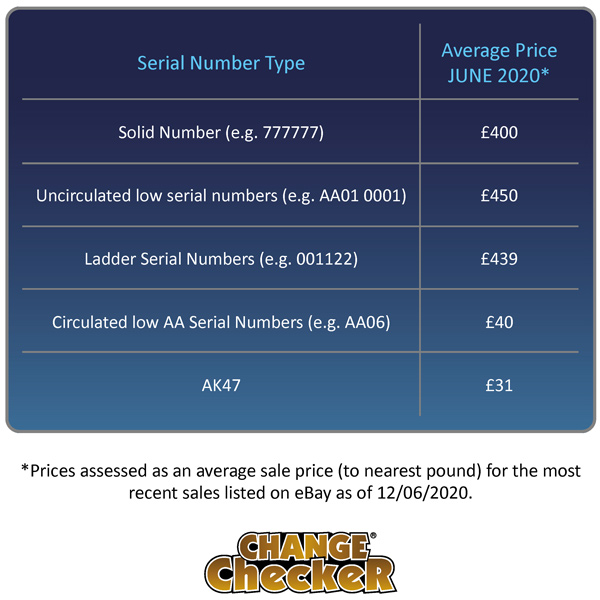
‘Rare’ polymer £20 banknotes
Recurring numbers
If you’ve been lucky enough to find a £20 note with a series of recurring numbers, like the 777777 serial number, you may want to keep hold of it as we’ve seen some which are currently selling on eBay for around £400 – over 20 times its face value!
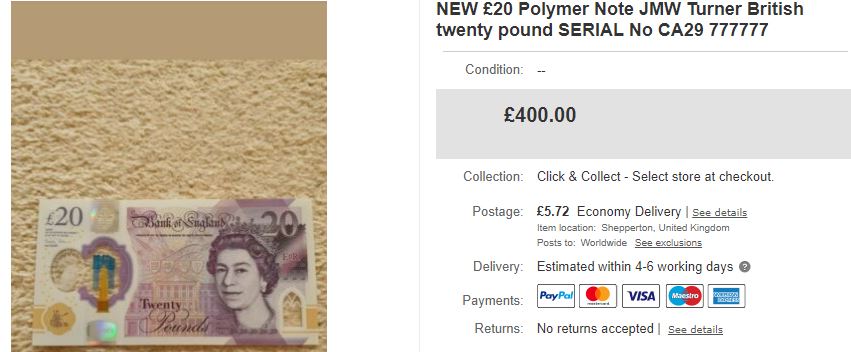
Similar serial numbers have sold for prices within the same range. The 333333 serial number also sold for £400, so it seems collectors everywhere are desperate to get their hands on a recurring number note!
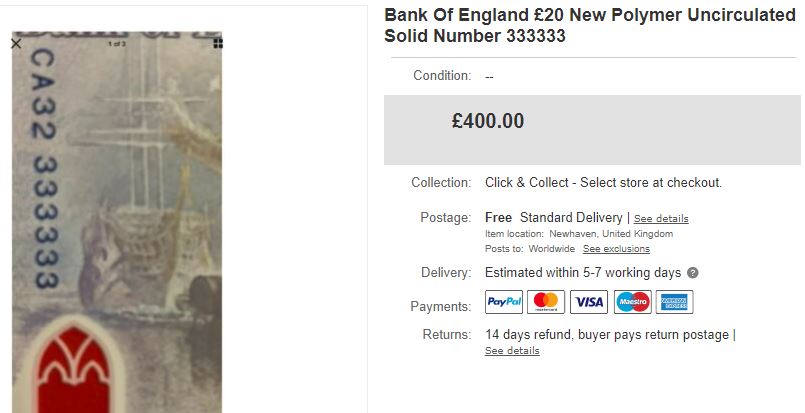
Another type of serial number you should be keeping an eye out for, is a ‘ladder’. These are serial numbers that have consecutive numbers, like this ‘001122’ note.
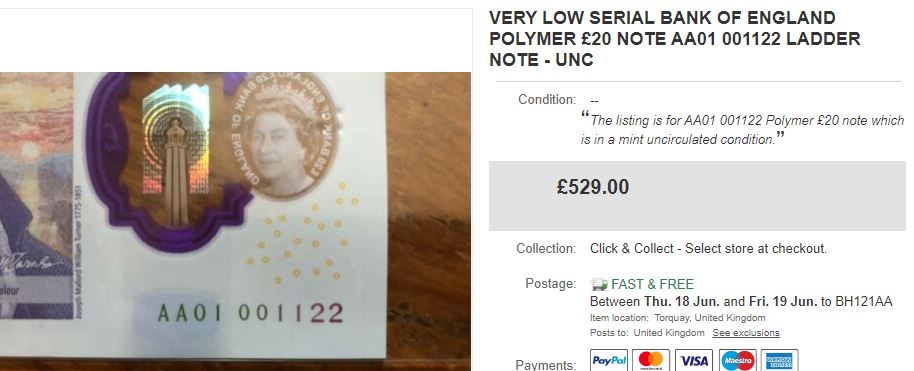
One lucky collector got his hands on this note but at a hefty £529… Other ladder numbers include ‘012345’ and these could currently fetch you a very respectful £350 on the secondary market!
AA numbers
As with previous polymer note issues, the lower serial numbers for the new £20 have proven popular with collectors, with the current average selling price for the AA notes coming in at £40! That’s two times the note’s face value!
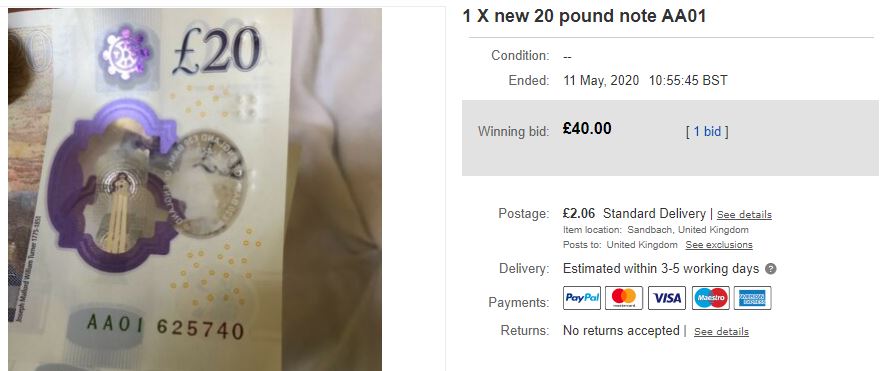
At the annual Bank of England charity auction held at Spink and Son Ltd in London the very first polymer note, the £5, with the serial number AA01 000017 auctioned for £4,150! However, this year, the £20 note with serial number AA01 000010 sold for a staggering £7,500, over FOUR times its starting price!
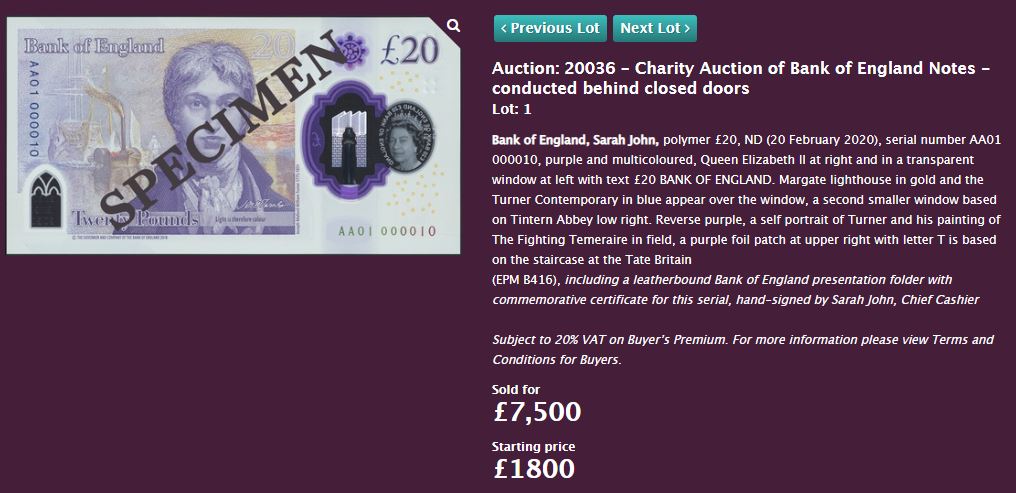
AK47
Considered collectable due to the machine gun connotations, polymer notes with the prefix AK47 were thought to be worth well over face value following the new £5 release in 2016.
A quick look at the most recent eBay sold prices for this serial number, on the new £20 note, show that people are willing to pay £11 over its face value!
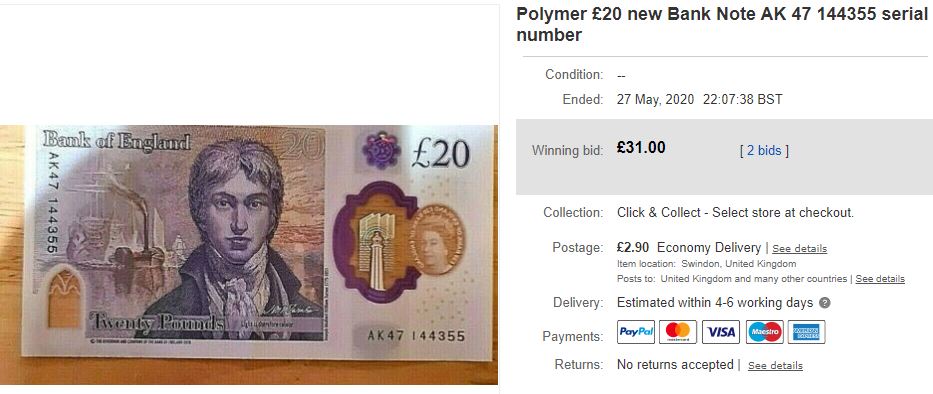
What about the £50 note?
The Bank of England will be issuing a new polymer £50 in 2021 featuring the scientist Alan Turing.

We can’t wait to see the new polymer £50 when it’s issued!
So there we have it, the current selling prices for your polymer £20 notes! With less cash being used during the current climate and therefore less notes in circulation, it’s possible this has added to the collectability of these new polymer £20 notes.
Are you a banknote collector and if so, which notes do you have in your collection? Let us know in the comments below!
If you’re interested in coin collecting, our Change Checker web app is completely free to use and allows users to:
– Find and identify the coins in their pocket
– Collect and track the coins they have
– Swap their spare coins with other Change Checkers

Sign up today at: www.changechecker.org/app
The new £20 note revealed!
The new design for the polymer £20 note has been officially revealed by the Bank of England and we can’t wait to start seeing it in our change next year!
The new £20 is coming on 20 February 2020.
— Bank of England (@bankofengland) October 10, 2019
Find out more: https://t.co/A23vZuf7Kg#TheNew20 pic.twitter.com/Lqyi0K2k4z
The design features JMW Turner, who was selected from the 29,701 nominations submitted by the public, making him the first British artist to feature on a UK banknote.
But what makes the new £20 note even more special is that is has been described by the Bank of England as the most secure note yet, with two windows and a two-colour foil which makes it difficult to counterfeit.
There are over 2 billion £20 notes in circulation, which makes the £20 note Britain’s most used (and also most forged) banknote.
Britain’s most secure banknote
Special features make the new polymer £20 note more secure, harder to forge and help it to stand out from other notes in circulation:
- Hologram – the word changes between ‘Twenty’ and ‘Pounds’ when tilted
- See-through windows – the foil on the front is blue and gold and the foil on the back is silver. There is also a second, smaller window in the bottom corner
- Raised dots – there are clusters of raised dots in the top left corner to help visually impaired people identify the note
- Ultra-violet number – under ultra-violet light the number ’20’ appears in red and green
- Purple foil patch – a round purple foil patch contains the letter ‘T’
- Historical character – JMW Turner’s self-portrait circa 1799 can also be seen on display in the Tate Britain
- Quote – “Light therefore is colour”
- The Queen’s portrait – printed on the back with “£20 Bank of England” printed twice around the edge
The Design
The bank note will feature Turner’s 1799 self-portrait – an image that currently hangs in the Tate Modern.
In addition, the note also features one of his most recognisable works, The Fighting Temeraire – a tribute to the ship which played a big part in Nelson’s victory at the Battle of Trafalgar in 1805.
A final touch of Turner, the note also includes a quote from the artist, ‘light is therefore colour’ and the signature taken from his will.
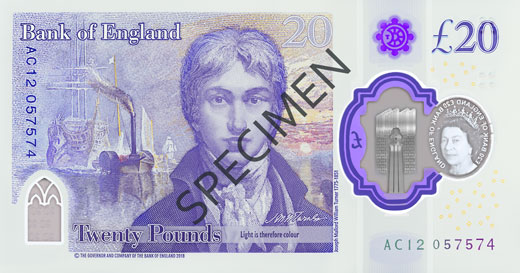
Excitingly for collectors though, the new £20 note will be the first to feature the signature of Sarah John – the Bank’s new cashier. So keep an eye out for this when you get your first polymer £20 note!
When can we expect to start seeing the polymer £20 note?
The new £20 note is due to enter circulation on 20 February 2020.
Initially the note will be in circulation alongside the existing paper £20 notes, which will eventually be phased out as we have seen with the paper £5 and £10 notes in the past years.
We are also expecting the new £50 polymer bank note featuring mathematician and second world war codebreaker Alan Turing in 2021.
So, how excited are you about the new £20 polymer note? Let us know in the comments below!
f you’re interested in coin collecting, our Change Checker web app is completely free to use and allows users to:
– Find and identify the coins in their pocket
– Collect and track the coins they have
– Swap their spare coins with other Change Checkers

Sign up today at: www.changechecker.org/app
Northern Ireland’s First Trust Bank to stop issuing their own banknotes
First Trust Bank, one of four main banks in Northern Ireland, will become the first Northern Ireland-based bank to end the practice of printing its own-denomination banknotes. The bank revealed it will scrap its own banknotes next year and switch to dispensing Bank of England notes from its ATM network.
Although the UK has a vast variety of different notes in circulation, The Bank of England is the only bank to issue notes for England and Wales, while there are seven different banks in Scotland and Northern Ireland that currently produce their own notes.

First Trust Bank currently their own banknotes in denominations of £10, £20, £5 and £100. Image Credit: The Irish Times
The decision is thought to be an economic issue and means that all existing First Trust banknotes will not be able to be used for payments from midnight on 30th June 2022. They can however be exchanged for Bank of England banknotes, or other sterling banknotes of equivalent value at Post Offices up until 30th June 2024.
Why do Scotland and Northern Ireland issue their own banknotes?
The UK has a vast variety of different notes in circulation and although those of us living in England and Wales don’t see many, there are three different banks in Scotland and four in Northern Ireland that currently produce their own notes.
In fact the tradition of printing banknotes was considered the norm centuries ago as most of the UK’s banks produced their own banknotes. However over time they weren’t all doing it responsibly and were not able to back the notes up with actual assets. The law changed in the 1840’s in England and Wales so all production of banknotes was moved to The Bank of England bar Scotland who argued for an exception as they were not having the same issues. The Bank Notes Act of 1928 allowed banks in Northern Ireland to produce their own notes.
For people living in Scotland and Northern Ireland, the banknotes are part of the furniture and a part of their cultural identity that usually feature local landmarks and historical figures. These issuing banks have also considered the notes as part of their marketing as customers are seeing the name of their banks in their hands as they spend cash.
Can you spend Scottish and Northern Irish banknotes in England?
Yes. The notes are legal currency and backed with physical assets with the Bank of England so can technically be accepted anywhere in the UK. However, the problems come as shops are not always overly familiar with all the different types of notes and may not be sure on how to check them for counterfeiting so don’t like to accept them.
Is this the beginning of the end for Northern Irish and Scottish banknotes?
The decision is scrap the printing of banknotes at First Trust Bank is thought to be an economic issue and comes as other Northern Ireland banks prepare for the change over to modern Polymer notes in the very near future. The update is needed in order to produce counterfeit resilient notes to protect against forgery and ensure the security of circulating notes. But this costly change could be too much for First Trust handle.

Scotland’s Clydesdale Bank was the first bank in the UK to issue a Polymer note in 2015. Image Credit: RBS
There are also a lot fewer of these notes changing hands and with the increasing use of digital payment methods and mobile technology, it could be the reasoning behind the decision to scrap the notes.
The other three Northern Irish banks are currently in various stages of issuing their own polymer £5, £10 and £20 notes and it is clear that Scotland are completely committed to keeping their own notes as Clydesdale Bank was the first bank in the UK to issue a Polymer note back in 2015.

